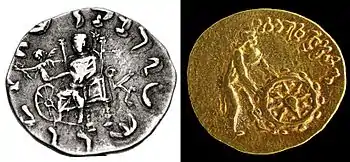Tillya Tepe Buddhist coin
The Tillya Tepe Buddhist coin is a gold coin that was discovered at the archaeological site of Tillya Tepe in modern Afghanistan.
| Tillya Tepe Buddhist coin | |
|---|---|
 Tillya Tepe gold coin at the Kabul Museum. | |
| Material | Gold |
| Size | Height: Width: |
| Writing | Obverse: Kharoshthi legend Dharmacakrapravata[ko] "The one who turned the Wheel of the Law". Reverse: Kharoshthi legend Sih[o] vigatabhay[o] "The lion who dispelled fear".[1] |
| Period/culture | 1st century BC - 1st century AD |
| Place | Tillya Tepe, Afghanistan |
| Present location | Kabul Museum, Afghanistan |
The gold coin from India was found in tomb IV (the male warrior). The archaeological site, as the coin, are dated to the beginning of the first century AD, that is late 1st century BC to early 1st century AD.[2]
Background

The coin was found in Afghanistan's Jowzjan Province, possibly the site of an early Indo-Iranian settlement. It was used as a necropolis for a wealthy family during the early Kushan period.[3]
Since the time of the Buddha, Buddhist representations had been aniconic. This raises the possibility that this coin is one of the earliest, if not the earliest, representation of the Buddha.[4][1]
Earlier connections between Greek deities and Buddhist symbolism appears on the coins of Indo-Greek kings such as Menander II (90–85 BC), in which Zeus, through Nike, can be seen handing a wreath of victory to a Wheel of the Law.[5] Like other pieces found at Tilya Tepe, there is a mix of Western Hellenistic style with Gangetic and northwest Indian elements.[6]
The coin is assumed to be destroyed or melted down by the Taliban in March 2001.[7]
Ideography
The ideography is the same as a plaster emblemata from Begram that depicts Heracles. Scholars have said the "representation seems to refer to the Vajrapani theme, which symbolizes the power of the Buddhist doctrine and tuition in Gandaharan art".[8]
Iconography
Obverse
On the obverse can be seen a man who is almost naked rolling a wheel. The legend in Kharoshthi reads Dharmacakrapravata[ko] "The one who turned the Wheel of the Law".[1] He is wearing nothing except a Hellenistic-style chlamys and a petasus hat (an iconography similar to that of Hermes/ Mercury).[9] Various identities have been suggested for the being depicted on the coins, from Shiva to Zeus, and most often, the Buddha himself in an early representation.[2][10][11][12]
Hermes was considered in ancient Greece as a psychopomp, an intercessor between mortals and the divine, and conductor of souls into the afterlife. Besides similarities in metaphysical roles, the similarity between the names of they respective mothers, Maya for the Buddha and Maia for Hermes, have often been noted, as well as the stories of their miraculous births.[13]
Reverse
On the reverse, it depicts a lion with the Buddhist symbol of the triratna, with the Kharoshthi legend Sih[o] vigatabhay[o] "The lion who dispelled fear".[1][14]
References
- Gérard Fussman et Anna Maria Quagliotti, The early iconography of Avalokitesvara L'iconographie ancienne d'Avalokitesvara, Collège de France, Publications de l'Institut de Civilisation indienne. Paris, Diffusion De Boccard, 2012. ISBN 978-2-86803-080-1. Quotation / Gérard Fussman, p.28
- Image Problems: The Origin and Development of the Buddha's Image in Early South Asia, Robert Daniel DeCaroli, University of Washington Press, 2015, p.21
- "Afghanistan Significant Site 207. Tillya Tepe". Cultural Heritage Training. CENTCOM Historical/Cultural Advisory Group. Retrieved 16 August 2019.
- Image Problems: The Origin and Development of the Buddha's Image in Early South Asia, Robert Daniel DeCaroli, University of Washington Press, 2015, p.20-26
- Bopearachchi "Monnaies Greco-Bactriennes et Indo-Grecques" p.313 sig.
- Behrendt, Kurt (2011). Gandharan Buddhism: Archaeology, Art, and Texts. UBC Press. p. 241. ISBN 978-0774841283. Retrieved 16 August 2019.
- Brown, Robert L. (2000). "The Walking Tilya Tepe Buddha: A Lost Prototype". Bulletin of the Asia Institute. 14: 77–87.
- Kābul, Mūzah-ʼi (2008). Afghanistan: Hidden Treasures from the National Museum, Kabul. National Geographic. p. 161. ISBN 978-1426202957. Retrieved 16 August 2019.
- Current perspectives in Buddhism: a world religion, Madhusudan Sakya - 2011, p.100
- Afghanistan, les trésors retouvés, p. 280.
- Image Problems: The Origin and Development of the Buddha's Image in Early South Asia, Robert Daniel DeCaroli, University of Washington Press, 2015, p.20
- Religions and Trade: Religious Formation, Transformation and Cross-Cultural Exchange between East and West, BRILL, 2013, p.102
- Treasures of Buddhism, Frithjof Schuon, Smriti Books, 2003, p.148
- An obverse and reverse view of the coin